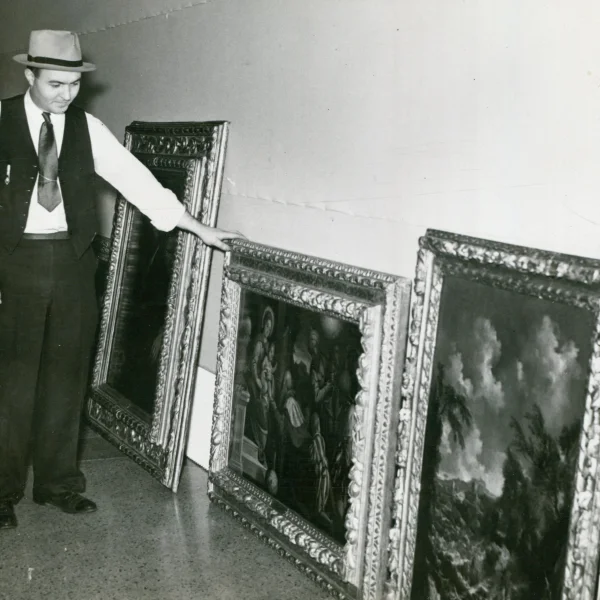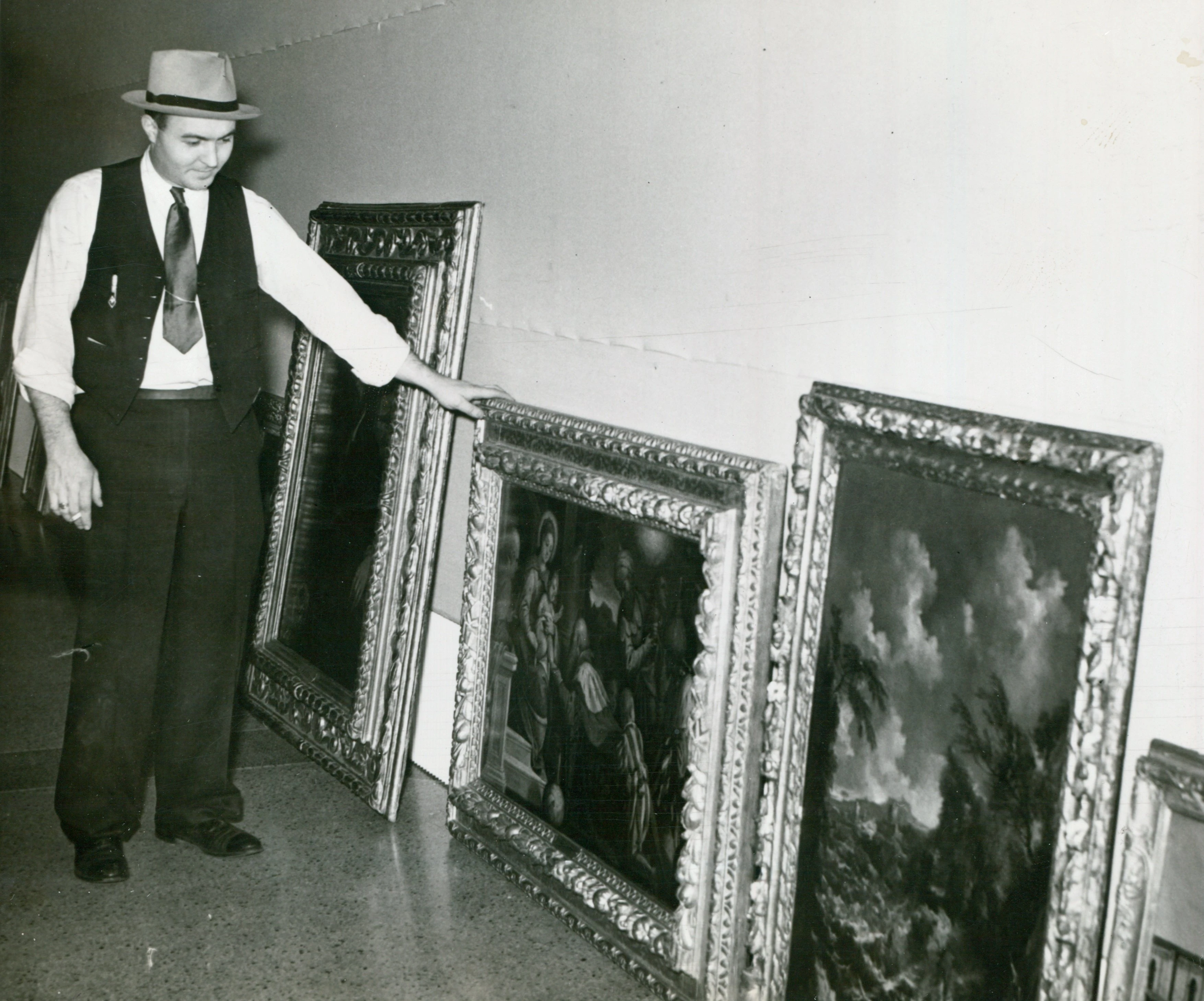In the spring of 1939, area residents flocked to the Bloomington Consistory to gaze upon paintings by the likes of Rembrandt, Renoir and Rubens. The Central Illinois Art Exposition drew national attention, with Time magazine calling it “the biggest and best exhibition of fine paintings ever held in a U.S. city of that size.”
It was the greatest art show in Bloomington history. Given the staggering increase in the value of these paintings over the ensuing nearly eight decades, it’s highly unlikely—neigh, unimaginable—that a show of this stature will ever again be mounted in the Twin Cities.
The once-in-a-lifetime exhibit featured a little more than 100 paintings from “old and modern masters” and contemporary American artists. The works included Rubens’ “The Bear Hunt,” Toulouse-Lautrec’s “Cirque Medrano,” and even Grant Wood’s “American Gothic.”
There were also paintings by Degas, Delacroix, El Greco, Gainsborough, Gauguin, Manet, Modigliani, Monet, Sisley, Tintoretto, Titian, Van Dyck, Thomas Benton, Thomas Eakins, Winslow Homer, Edward Hopper and more.
All the works were on temporary loan. The Rubens came from the Silberman Galleries in New York City, for example, and the iconic Wood from the Art Institute of Chicago. Other donors included the Brooklyn Museum; Corcoran Gallery of Art, Washington, D.C.; Whitney Museum of Art, New York; and the Carnegie Art Institute in Pittsburgh.
“Bespatted legionnaires” with gilded rifles, led by American Legion Commander Art P. Kane, served as the honor guard. Also on hand for round-the-clock watch duty were law enforcement officers from the city and county.
The spring 1939 exhibit ran from Mar. 19 through Easter Sunday, Apr. 9, on the lower floor of the Consistory (now the Bloomington Center for the Performing Arts). Admission was 25 cents, which adjusted for inflation would be the equivalent of about $4.50 today. Students, though, were free. Attendance for the three-week show topped 41,000, or almost 2,000 per day, with students comprising about half that number.
Illinois State Normal University President Raymond W. Fairchild accepted the chairmanship of the school committee, which contacted 230 downstate school systems. By the end of the exposition, students from 78 communities, including Kewanee, Sibley and Champaign, participated in supervised tours. In order to accommodate the crush of students during the 15 school days of the exposition, organizers guided them through in groups of 50 spaced 10 minutes apart.
The driving force behind the exposition was The Pantagraph’s 32-year-old publisher Loring “Bud” Merwin, described by Time magazine as the “green-eyed, dark-headed, infectious Harvardman.” Serving as the show’s general chairman, Merwin envisioned the event as a way to boost the prospects, aesthetically and financially, of Bloomington, which like the country as a whole found itself mired in the decade-long Great Depression. Thus this exposition served not only to bring incomparable works of fine art to the downstate masses, but also to boost community pride and, not inconsequentially, retail sales of downtown merchants.
Incredibly, Merwin’s first idea was to bring the “Mona Lisa” to Bloomington! He and Drew Pearson, a Washington, D.C. columnist, proposed such a plan to the French ambassador, but were told that given the time constraints and the red tape, the Leonardo da Vinci masterpiece could not be secured for a temporary trans-Atlantic loan.
Alan D. Gruskin of New York City’s Midtown Galleries was brought in to serve as the exposition’s curator. Let it be noted that the collection on exhibit mirrored the 34-year-old Gruskin’s rather conservative taste for academic and realist painters at the expense of abstract art.
At first, Gruskin found little interest among leading museums and galleries, both private and public, in participating in the small city show. His first break came when the William Rockhill Nelson Gallery in Kansas City agreed to furnish El Greco’s “The Penitent Magdalene.” Once this gallery signed on, other galleries and institutions followed.
To pay for the show, the executive committee received financial commitments totaling around $10,000 from more than 130 mostly local organizations, businesses and individuals, such as the Paul F. Beich Co., Peoples Bank, A. Livingston & Sons and G.J. Mecherle. The two costliest outlays were Consistory rent ($1,225) and Gruskin’s fee ($750). In the end, given the better-than-expected revenue from ticket receipts and the sale of a 10-cent souvenir booklet, the exposition committee ended up returning more than 80 cents of each donated dollar.
Effusive praise for the exposition came from middle and highbrow corners alike. National magazines raved about the show. “Finest Art in U.S. Goes to Illinois Corn Belt,” read a Life magazine headline to an article that included photographs by Alfred Eisenstadt. “This is the best show outside of the three or four leading museums in America that I have ever seen,” said Chauncey McCormick, vice president of the Art Institute of Chicago.
Others were equally impressed. “Bloomington is the laboratory for a new idea in art, bringing art to the people instead of people to art,” commented critic Peyton Boswell, writing in the Apr. 1, 1939 issue of The Art Digest. He called the effort “one of the most important exhibitions held in America in recent years.” It also dovetailed well with one of the founding principles of The Art Digest—namely, “the decentralization of art production and art consumption away from the narrow ribbon of the Atlantic seaboard, lest American art suffer premature senility.”
Even the “shadowless” lighting scheme, billed as state-of-the-art, drew raves. “Blue daylight bulbs and reflectors give uniform lighting to the entire area of each picture twelve hours a day—illumination superior to that in most of the paintings’ home museums and galleries,” noted Newsweek magazine.
A special committee purchased one of the paintings on exhibition, Frederick Taubes’ “Seated Woman,” and handed it over to the Bloomington Art Association. Today, this painting is in the permanent collection of the McLean County Arts Center.
In the fall of 1989, the Art Center staged a 50th anniversary show of the exposition. Though not as large and ambitious as its predecessor, it did include works on loan by Manet, Toulouse-Lautrec and others.

